SPECworkstation 3.0.2 Storage Benchmark
SPECworstation benchmark is an excellent benchmark to test systems using workstation-type workloads. In this test, we only ran the Storage component, which is fifteen separate tests.
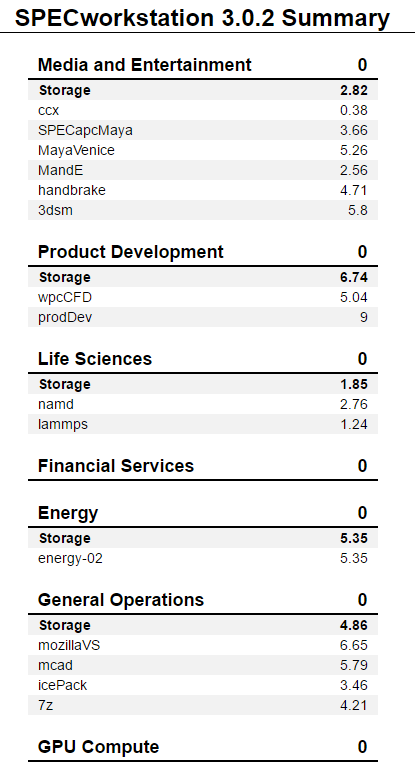
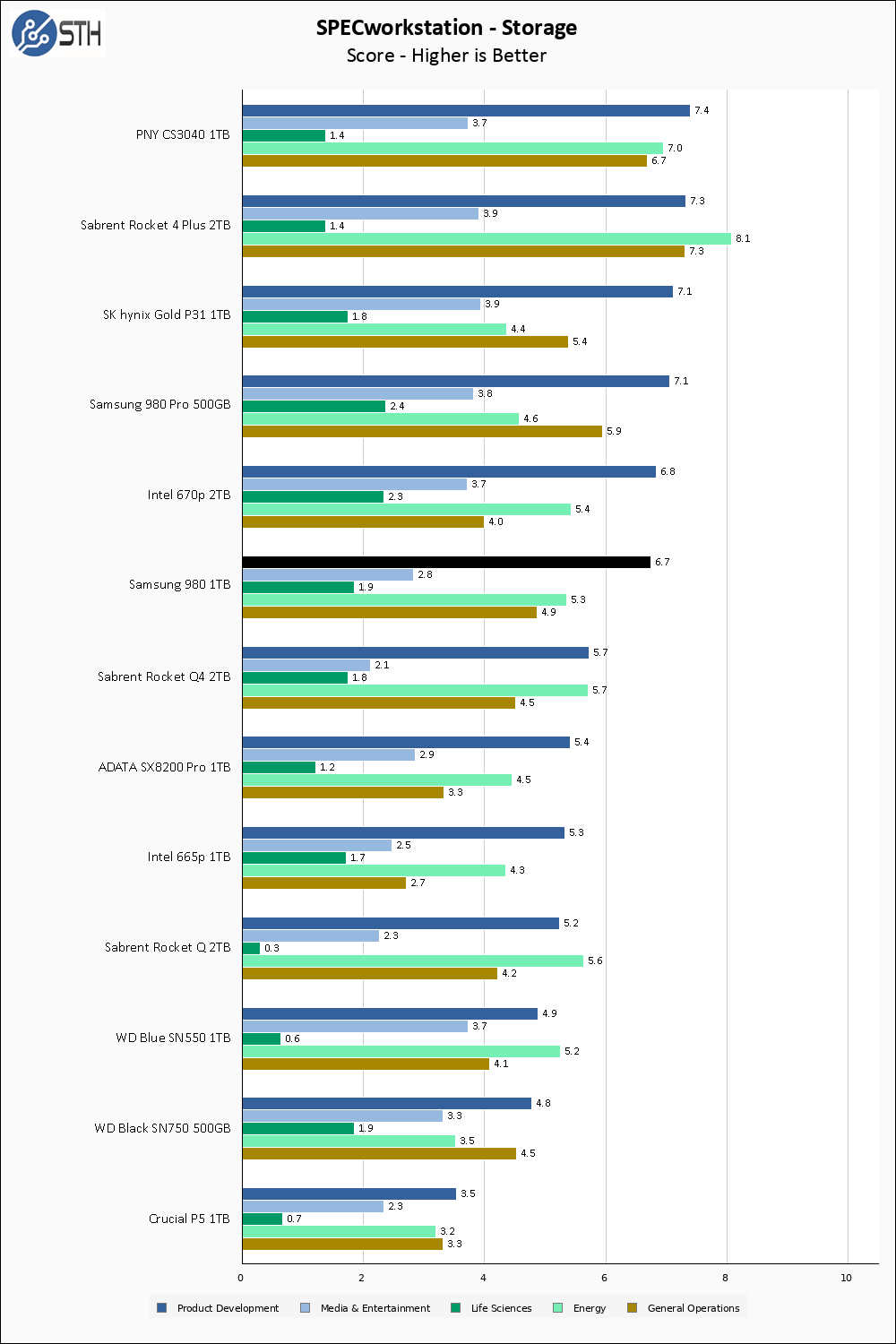
The Samsung 980 1TB has overall good performance in SPECworkstation, trading blows with the other high-performance PCIe 3.0 SSDs.
Sustained Write Performance
This is not necessarily a benchmark, so much as trying to catch the post-cache write speed of the drive. While I am filling the drive with data to the 85% mark with 10 simultaneous write threads, I monitor the drive for the write performance to dip to the lowest steady point and grab a screenshot.
This is a new section to my reviews, and something I plan to track from now on. Since I have not been gathering this data up until recently, I do not have historical data from my other reviews. Once I do I will start including comparison graphs.
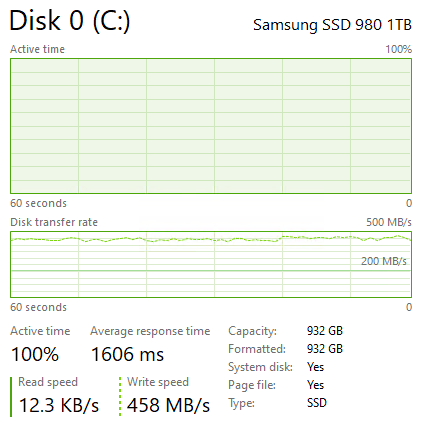
Settling in at a sustained post-cache write speed of around 450 MB/s, the Samsung 980 1TB is respectable but certainly not class-leading on this test.
Benchmark Comparisons
We are going to compare the Samsung 980 1TB with its predecessor drive, the 970 EVO Plus, as well as its big brother the 980 Pro. Unfortunately, neither drive in our test set was tested at the 1TB capacity point, but we will do the best we can.
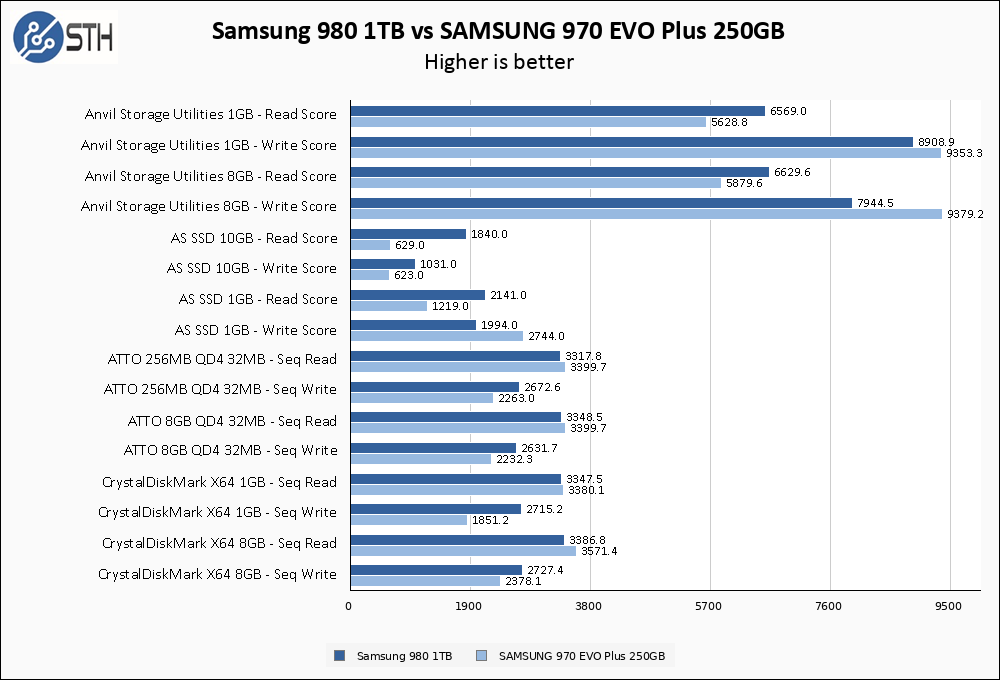
Comparing directly against its predecessor in the 970 EVO Plus 250GB, the Samsung 980 1TB has mixed results. In general, the 970 EVO Plus manages to edge out the 980 in sequential read workloads, while tests that factor in random read tends to favor the 980. Unfortunately the 970 EVO Plus 250GB is operating at a handicap; the smaller amount of NAND directly translates to fewer populated channels on the 970 EVO Plus’s controller, and had the benchmark been apples to apples with 1TB drives it is entirely possible the 970 EVO Plus could have an even stronger showing. Even when comparing against the baby 970 EVO Plus drive, the 980 1TB cannot claim a clean victory.
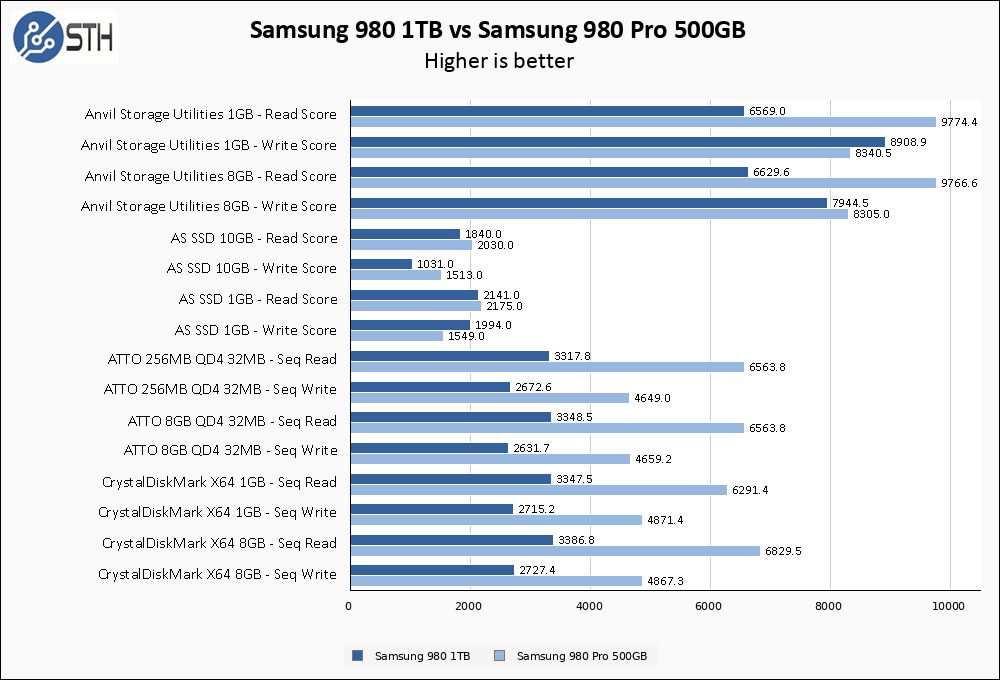
Meanwhile, comparing the 980 1TB to the 980 Pro 500GB was never going to be a fair fight. The PCIe Gen4 980 Pro is simply faster than the PCIe Gen3 980, as should be expected.
Temperatures
We monitored the idle and maximum temperature during testing with HWMonitor to get some idea of the thermal performance and requirements of the drive. Please keep in mind that our test bench is an open frame chassis in a 22C room, but with no direct airflow. As a result, this is not representative of a cramped low airflow case and is instead intended to model temperatures of a drive ‘on its own’.

Thermals on the Samsung 980 1TB were a bit warm. Peaking at 69C, this drive is certainly not the model of electrical efficiency like the SK hynix Gold P31 1TB, but it should not require extra cooling in most circumstances.
Again, we are mostly looking for the absence of runaway thermals here during our testing rather than comparing drives to each other.
Final Words
The Samsung 980 1TB is $130 on Amazon, which is in line with pricing of other premium PCIe 3.0 SSDs like the SK hynix Gold P31 1TB, and below the price point of Samsung’s own 970 EVO and 970 EVO Plus 1TB. In a key differentiating factor, though, is that those drives are not DRAMless. It is, however, a few dollars more than the more value-oriented drives like the WD Blue SN550 1TB or the HP EX920 1TB. Samsung seems to be aiming for ‘mainstream’ more than ‘entry-level’ but I think there was an opportunity for a $120 price point that would have been more compelling.
The Samsung 980 1TB seems very much like a transitional product. It does not clearly outperform its predecessor, and many enthusiasts will look very suspiciously on a premium/mainstream drive that lacks a DRAM cache. Given the single NAND package and lack of DRAM it is undoubtedly less expensive to produce than the 970 EVO before it, but that is a factor for Samsung to consider and not particularly something consumers will care about, especially given that Samsung has not reduced the price of the 980 very far below the 970 EVO predecessor. With that said, the Samsung 980 1TB is still a competitive drive that would work very well in almost any PCIe 3.0 NVMe system.

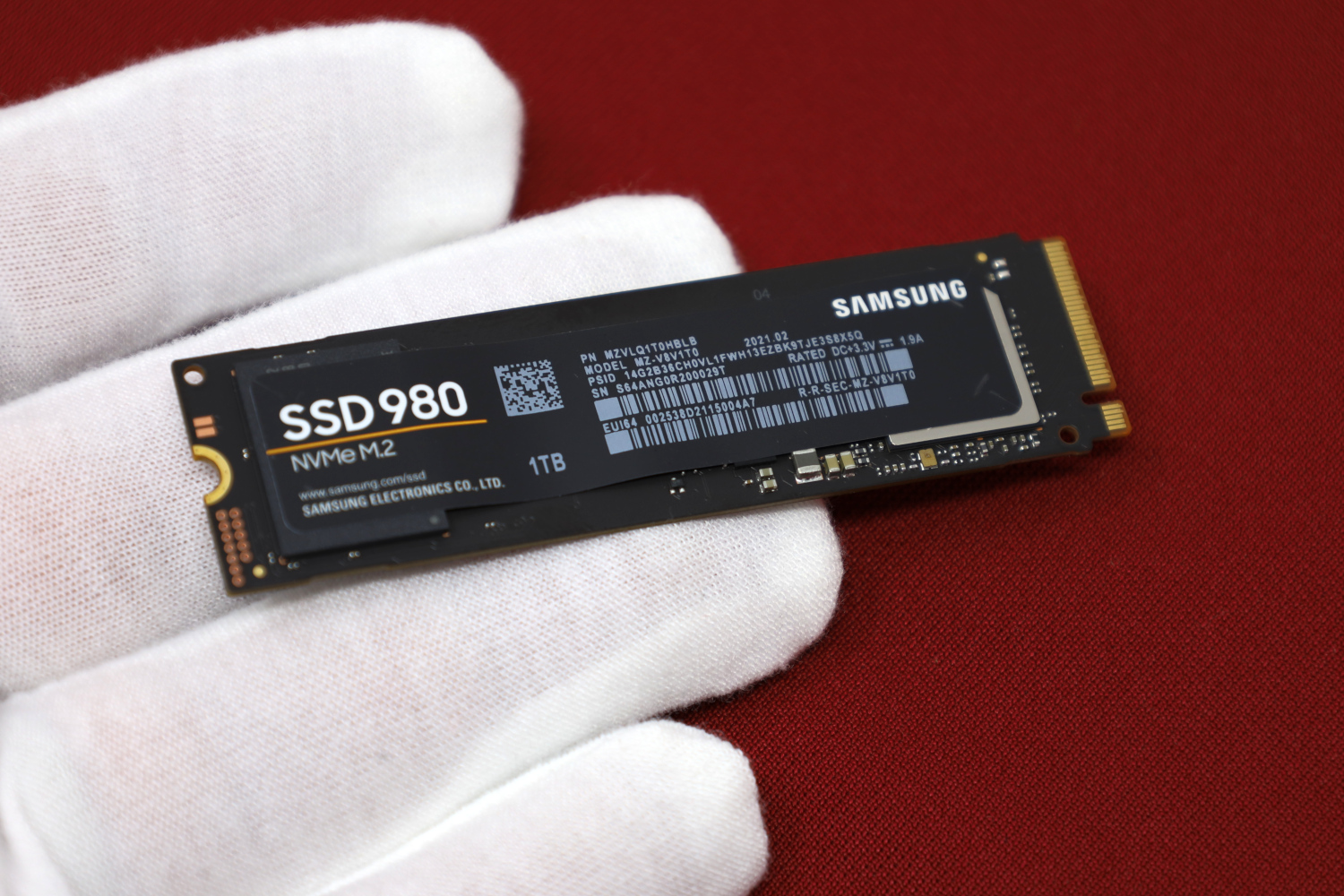



Will, nice writeup as usual. I enjoy seeing the usual suspect benchmarks I’ve been using for a while. I enjoy the range of storage options presented here at STH. For CrystalDiskInfo, is there a benefit to keeping the default hex values on the drive info screenshot? I realize most of the pertinent info is at the top of the screen, for a new drive especially, but if you’re going to show the full screen, how about using the decimal view for the lower portion? From memory it’s Settings > Advanced Features > Raw Values > 10 DEC, or somewhere in that vicinity. At least for me, decimal is WAY easier to interpret the values there, such as host writes versus NAND writes, max drive temperatures, accrued errors and ECC events, etc.
MOSFET,
Not in particular. I have even had the suggestion to change it before, I’m just a bit forgetful and it isn’t necessarily information I’m looking to see. I’ll try to remember in the future!
Nice write up, I was really enjoying reading it, BUT…
WTF!? You’re comparing apples to oranges here! The 980 looked like it may be a solid performer depending on price, but then I realized you’re comparing a:
1TB 980 vs 500GB SN750 vs 250GB 970 EVO Plus!
If I have to explain WHY this is a problem, then you shouldn’t be posting or reading reviews. A 1TB 970 EVO Plus would probably crush this drive in benchmarks!
Nice write up, I was really enjoying reading it, BUT…
WTF!? You’re comparing apples to oranges here! The 980 looked like it may be a solid performer depending on price, but then I realized you’re comparing a:
1TB 980 vs 500GB SN750 vs 250GB 970 EVO Plus!
If I have to explain WHY this is a problem, then you shouldn’t be posting or reading reviews. A 1TB 970 EVO Plus would probably crush this drive in benchmarks!
Jmcgrath, if you’re too lazy to explain in the first place then you shouldn’t be popping out of your trashcan.
Nice review Will, it actually doesn’t seem a bad drive despite being dramless and a worthy option. It feels like the controllers are getting good enough and the backing nand is also getting good enough to “get away” with not having dram.
JMcGrath,
I can only use comparison points for drives that I’ve benchmarked, and unfortunately I haven’t personally benchmarked a 1TB SN750 or 1TB 970 EVO Plus, which in the 970’s case is something I point out in the comparisons segment of the review. When comparing directly to the only 970 EVO Plus I have benchmarked I literally state “Unfortunately the 970 EVO Plus 250GB is operating at a handicap; the smaller amount of NAND directly translates to fewer populated channels on the 970 EVO Plus’s controller, and had the benchmark been apples to apples with 1TB drives it is entirely possible the 970 EVO Plus could have an even stronger showing. Even when comparing against the baby 970 EVO Plus drive, the 980 1TB cannot claim a clean victory.” As for the SN750, I do not go out of my way to draw comparisons to that drive at any point in the review. I think a more apt comparison point would have been the SK hynix Gold P31 1TB, which is an equivalently priced drive and whose results are included on every benchmark graph.
I’m interested to see if this will be whitelisted for the PS5.
No, it should be a part of benchmarking to test the sustained write for non-MLC SSDs. And I didn’t get, at what point exactly does it drop to raw TLC write speeds? How many gigs is the cache size there?
slc,
“How many gigs is the cache size” is nearly an irrelevant question, since almost all modern drives use an at least partially dynamic cache system, and the amount of available cache will depend on how full the drive is at any given moment in time. This is why I am now measuring and reporting the post-cache write speed, so that readers have knowledge of ‘worst case scenario’ write speed.
I don’t see the point even if you are on pci e why not just get the pro model so you have dram on the nvme and you don’t hit yourself on the life of the drive.
I appreciate the review. BUT, no matter how much you mention in the text, many will only look at the graphs. It’s fine to present “all the drives I’ve tested” as a reference chart, but of more value to purchasers I think would be a chart comparing “only 1TB drives”. IMO far more consumers shop for a particular size than a benchmark number, and that benchmark number really only means something when comparing the various price points for a given capacity.
Useful as ZIL SLOG device? No RAM implies no lost data on power failure?